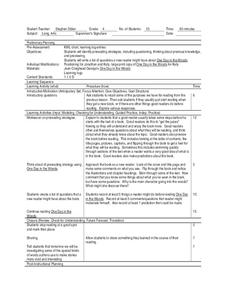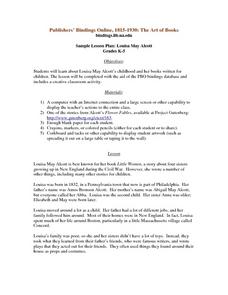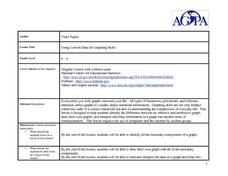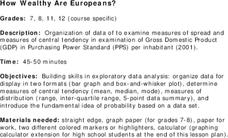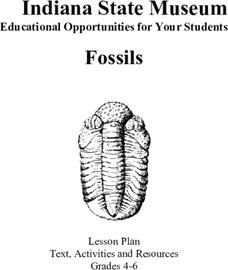Curated OER
Supreme Court: Background
Students explain the role of the Supremem Court under the Constitution. They explore current evetns related to the Constitution and read about the roles of the Senate and President in selecting the next justice. They create a chart about...
Curated OER
The Mysterious Tadpole
Second graders examine books written by Steven Kellogg, looking for similarities in his illustrations. They also look at images found on the Internet. They listen to a read aloud of The Mysterious Tadpole up to the point where the eggs...
Curated OER
The Arctic and Taiga Ecozone of Canada
Students examine the various sub-regions of the Arctic and Taiga zones in Canada. Using the online Canadian Atlas, they locate and describe the characteristics of each zone. They organize their information into a chart and share it with...
Curated OER
Social Studies: Canadian City Comparison
Students research Canadian population distribution while comparing and contrasting the quality of life in two cities. They discuss issues and problems that cities and rural towns face. Students apply various methods, such as graphs and...
Curated OER
No Title
Fourth graders identify and practice a variety of prereading strategies to assess how to ask questions that a new reader might ask about the book, "One Day in the Woods." They skim the book, brainstorm the topic of the book and preview...
Curated OER
Population Growth
Students investigate the biodiversity of living things and how they are interdependent upon each other. They conduct research using a variety of resources. Specifically students create a graph to show how a population can grow in an...
Curated OER
Survival Of The Fittest
Seventh graders examine the concept of an ecosystem and how there is a variety of representations of life that exist there. They look at the equilibrium that is reached in stable communities and how the variable of change in...
Curated OER
Design and Technology - Pneumatics
Students engage in a lesson that is about constructing an airbleed circuit while suggesting practical applications for the circuit after conducting some research. To help in the construction students watch a video to watch an example.
Curated OER
Locating the Salt Front
Learners use Hudson River salinity data to create a line
graph that shows the location of the salt front, and use math
skills to explore how this location varies over time. They use the graph to estimate the location of the salt front...
Curated OER
Lousia May Alcott
Students examine the life of Louisa May Alcott. Using the Internet, they examine the types of books and plays she wrote. In groups, they compare and contrast the types of covers used on the various publishing's. They design and color...
Curated OER
Earthquakes!
Students experiment with the concept of earthquakes while completing a lab with marshmallows, toothpicks, modeling clay and firm Jell-O and rectangular pan. They explore what kind of soil earthquakes do the most damage in and how...
Curated OER
Using Current Data for Graphing Skills
Students graph demographic information. In this graphing instructional activity, students choose what type of graph to create and what information to display. Links to examples of graphs and statistical data are provided. The graphs are...
Curated OER
Domino Dash
Eighth graders examine the relationship between speed, time and distance. In this motion lesson students complete a lab activity that allows them to calculate average speed.
Curated OER
Square Numbers Closure Activity
Students discuss square numbers. In this math lesson, students find square numbers and support their answers. Students find sums and products that are square numbers.
Curated OER
Voices From Your Heart
Students create individual representations of Chinese calligraphy symbols in this cross-curricular lesson for the elementary Language Arts or Art classroom. One enrichment activity is included.
Curated OER
How Wealthy Are Europeans?
Students investigate measures of central tendency. They examine compiled data and conduct critical analysis. The graph is focusing on the gross domestic product data. The lesson also reviews the concept of putting values in order of...
Curated OER
Temperature Comparisons
Students practice plotting temperature data points on a line graph in groups and examine the temperature differences at the same time of year. They graph the temperatures in Lannon, WI, and Mitchell's Plain, SA. After the data has been...
Curated OER
Investigating Porosity and Permeability
Student describe porosity and permeability in sand, gravel, clay and potting soil. They experiment using different materials to discover the different porous substances and the permeability of the same substances. Young scholars place...
Curated OER
Perimeters, Patterns, and Conjectures
Students discover patterns and write conjectures relating to perimeters and polygons. Working in cooperative learning groups, they use manipulatives and graphic organizers to solve problems then answer a series of questions in which they...
Curated OER
Let's do dinner
Students observe the benefits of family structured activities. In this social studies lesson, students keep a journal of their experience in having dinner with their families every night for a week. Students research the importance of...
Curated OER
Penny Moves
Students explore math functions by completing a worksheet in class. In this spatial movement lesson, students utilize a four square grid and a penny to practice moving the coin horizontally, vertically and diagonally as instructed....
Curated OER
Double Dipping
Fifth graders determine how many double scoop combinations they can make using 5 different ice cream flavors. Then they use Microsoft Publisher to create a brochure for their ice cream shop.
Curated OER
Guess Who's Coming to Dinner?
Learners work in groups to imagine, research and simulate a dinner party involving an author, a fictional character, and a significant historical figure as dinner guests. The activity uses Geoffrey Chaucer's Canterbury Tales and the time...
Curated OER
Fossils
Students complete a unit on fossils. They read and discuss informational handouts, define key vocabulary terms, answer discussion questions, create a geologic timeline and a timeline of their own life, analyze bones, and create a fossil...






